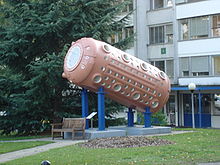
Back Gargamelle Czech Gargamelle German Cambra ed Gargamèla EML Gargamelle (détecteur) French גרגמל (גלאי חלקיקים) HE Gargamelle Hungarian Գարգամել Armenian Gargamelle Italian Gargamelle Polish Gargamela Portuguese


Gargamelle was a heavy liquid bubble chamber detector in operation at CERN between 1970 and 1979. It was designed to detect neutrinos and antineutrinos, which were produced with a beam from the Proton Synchrotron (PS) between 1970 and 1976, before the detector was moved to the Super Proton Synchrotron (SPS).[1] In 1979 an irreparable crack was discovered in the bubble chamber, and the detector was decommissioned. It is currently part of the "Microcosm" exhibition at CERN, open to the public.
Gargamelle is famous for being the experiment where neutral currents were discovered. Found in July 1973, neutral currents were the first experimental indication of the existence of the Z0 boson, and consequently a major step towards the verification of the electroweak theory.
Gargamelle can refer to both the bubble chamber detector itself, or the high-energy physics experiment by the same name. The name itself is derived from a 16th-century novel by François Rabelais, The Life of Gargantua and of Pantagruel, in which the giantess Gargamelle is the mother of Gargantua.[1]
- ^ a b "Gargamelle". CERN. Retrieved 12 August 2017.
© MMXXIII Rich X Search. We shall prevail. All rights reserved. Rich X Search